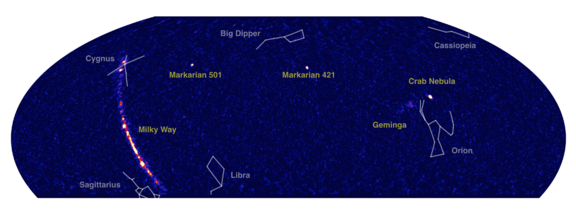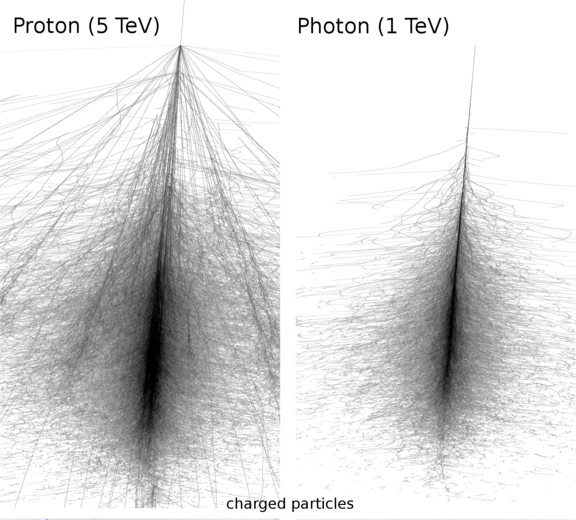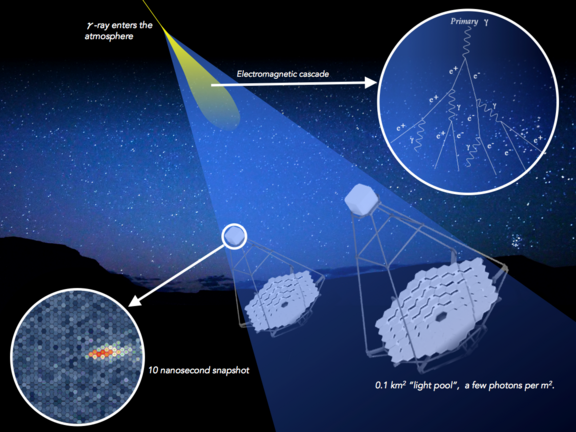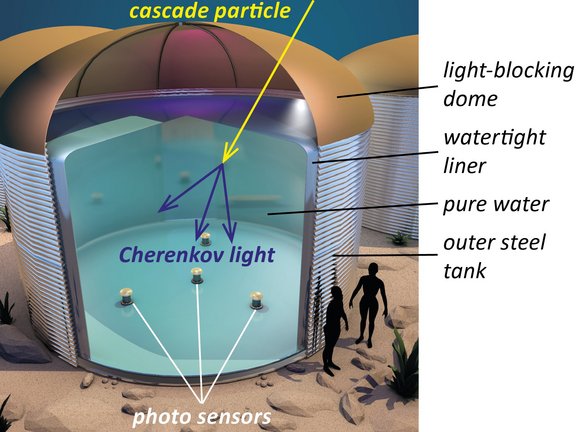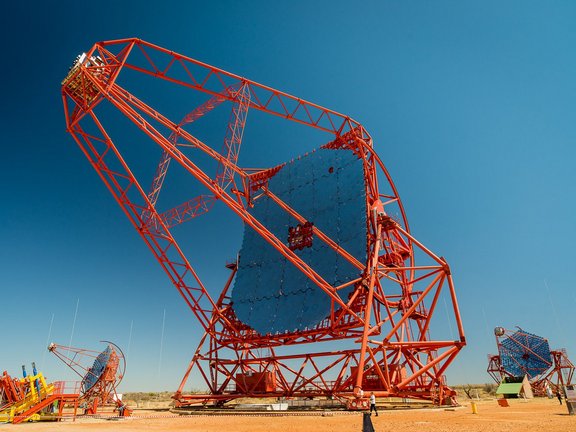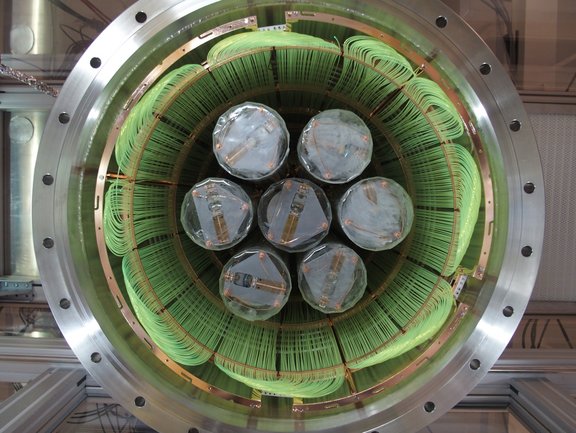The non-thermal universe – Cosmic rays and very high energy photons
Many regions in our universe can be described perfectly well by thermal processes – where we have a clear relation between a temperature and the energy distribution of the atoms or particles involved. The energy input into these processes typically comes from nuclear fusion in stars and the emitted electromagnetic spectrum, from the cosmic microwave background, through X-ray emission by clusters of galaxies, to the light from the Sun and stars can often be described fairly well by the Planck radiation formula.
In the non-thermal part of the universe we are far from a thermal equilibrium. Particles gain their often enormous energies by other processes, often resulting in power-law spectra (dN/dE proportional to E-k) extending over many orders of magnitude in particle energy E. Apart from electromagnetic radiation, extending far into the gamma-ray domain, the sources also emit the accelerated or otherwise produced particles themselves, including nuclei and electrons but also neutrinos. The energy for that often originates from a stellar collapse, from the rotational energy of a neutron star or from the accretion of matter into a black hole, naming just a few examples.
The messengers of this non-thermal universe include the so-called "cosmic rays", energetic particles arriving on Earth after meandering through our Galaxy and beyond for a long time. The particles are mainly atomic nuclei, starting from protons up to the heaviest nuclei, and electrons but also some of their anti-particles: antiprotons and positrons. The acceleration sites and the processes going on there can be better studied via electromagnetic radiation (photons) from radio waves to extremely energetic gamma rays. These come directly from the sources, without deflection by the galactic and intergalactic magnetic fields. Neutrinos would be suitable messengers as well but are way more difficult to detect.
Apart from the obvious question for the century-old question for the origin of cosmic rays and studying acceleration mechanisms, the research program includes topics of particle physics such as the search for the annihilation of dark matter or hints of other kinds of hypothetical particles. For a few examples of currently investigated areas see, for example, the pages of the H.E.S.S. experiment.
Detection of cosmic rays and gamma rays from particle cascades in the atmosphere
For the 'direct' detection of these particles you need a detector above the Earth's atmosphere – limited to the order of a square meter by the enormous costs of building & launching detectors to space. By including the atmosphere as a part of our detector we can achieve detection areas many orders of magnitude bigger than that. The requirement is that the particles have enough energy to start a cascade of secondary particles called an 'extensive air shower'. Examples of simulated cascades are illustrated on the right.
There is a range of detection techniques available for these particle showers. Either the (often very few) secondary particles arriving at ground level are detected or the Cherenkov light or fluorescence light emitted by particle high in the atmosphere or radio waves produced by the shower in a more coherent way.
The best sensitivity at a low detection threshold is achieved with stereoscopic arrays of imaging atmospheric Cherenkov telescopes such as H.E.S.S..
While the telescopes can only observe during the night and need to pointed towards the observed region of the sky, the detectors for particles arriving at ground level can observe around the clock and do this at the same time for a large fraction of the visible sky. HAWC is an excellent example of such an instrument, in this case consisting of large water tanks instrumented with photo-multipliers as particle detectors.
While H.E.S.S. and HAWC are in operation for several years now and have resulted in many spectacular results, the development of new instruments never stops. In the area of Cherenkov telescopes, the plans and development for CTA are well advanced, although its implementation will take a few more years. The MPIK is involved here in particular with the FlashCam and CHEC camera systems and also in computer simulations. While CTA was designed to consist of a site in the Northern Hemisphere and a site in the Southern Hemisphere right from the start, a counterpart to HAWC on the Southern Hemisphere – the Southern Wide-field Gamma-ray Observatory SWGO – is just starting to be planned.
Laboratory-based astroparticle physics
Neutrinos are electrically neutral elementary particles of tiny mass which occur as three different types, so-called flavours. Besides photons, they are the most abundant particles in the Universe, but we don’t notice them as they interact only rarely with matter. Thus, sensitive detectors with excellent shielding against background signals are required to detect them.
A neutron inside a nucleus β-decays to a proton, an electron and an antineutrino leading to another element. Some atomic nuclei, one of them the germanium isotope 76Ge, are not subject to the single but instead the double-β decay: two neutrons are decaying at the same time with either two or no neutrino. The GERDA experiment searches for the neutrinoless double-β decay in pure germanium crystals enriched with 76Ge. Neutrinoless double-β decay, if allowed by rules of conservation, is an extremely rare event. Until now, no evidence for the decay was found – only that its half-life in 76Ge must be at least 1026 years. The next generation of experiments is already on track to improve upon those measurements: LEGEND, the successor of GERDA, uses a larger amount of germanium and more advanced techniques to suppress background events.
